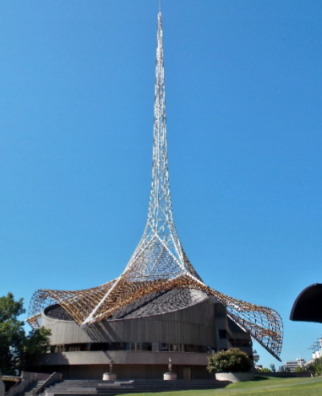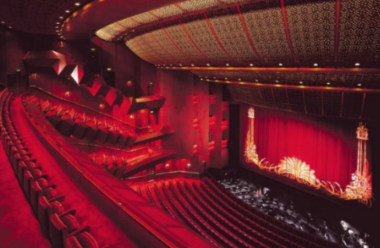The Melbourne Arts Centre, is a performing arts centre including a complex of theatres and concert halls in the Melbourne Arts Precinct.
It is located in the central Melbourne district of Southbank. Alongside it runs the Yarra River and on the other side, St Kilda Road, one of Melbourne’s main roads.
The Arts Centre was designed by architect Roy Grounds. The plan for the build was approved in 1960 and the construction began in 1973 after some delays. The complex opened in different phases, the Hamer Hall was opened in 1982 and the Theatres building was opened in 1984.
Some major companies that perform on a regular basis in the Arts Centre are: Opera Australia, The Australian Ballet and the Melbourne Theatre company. Additionally, it also hosts many Australian and international performances and production companies.
The site is listed on the Victorian Heritage register.
History of the Melbourne Arts Centre
The site that the Arts Centre is built on, has long been associated with arts and entertainment. In the beginning of the 20th century it was occupied by an amusement park, a circus venue, a dance hall and a cinema. The neighbourhood was a trendy location featuring an Ice-Skating rink, the Olympia Dancing Place, a Japanese tea house and Snowden Gardens. In 1907, the Wirth’s Circus appeared with a 5000-seat auditorium.
Vicki Fairfax wrote in the book ‘A Place Across the River’ that the lot is an “oddly shaped piece of land”, which was considered a sacred public spot by the locals.
There was a push to establish a new home for the National Gallery of Victoria and the state theatre on the site, during World War ll. The construction was hard due to the triangular parcel of the land. By the 1960s, all the entertainment had left and the lot had turned into a parking lot for city workers.
Reconstruction of the Melbourne Arts Centre
After some time, Roy Grounds was chosen as the architect. His plan of a gallery and an adjacent theatre under a tall copper spire was approved in 1960. The main challenge of the project was to dry up and retain the waters out of the base, as the construction went 7 metres below water levels.
The original idea of the spire was 115 metre tall, and it was one of the first structures in Australia to rely on computer-aided-design, due to its complexity. In 1968, the gallery was completed, and the theatres were planned to be built during the second stage.
An expansion was required for the theatre and concert hall in the early 1970s. Roy Grounds completely redesigned the project, due to the addition of a smaller second theatre and to accommodate difficulties associated with the geology of the site. The concert hall was separated and placed in the riverbank, and the theatre building was expanded above the ground, with a latticework spire above.
Construction of the Theatre at the Arts Centre
In 1973, the work began on the theatre site, but digging was not completed until 1987. In 1978, work began on the concert hall site. Rupert Hamer took on responsibility for the first phase of the project between 1972 and 1979, as Minister for the Arts. Norman Lacy took the lead during the main construction phase from 1979 to 1982. The spire was completed by Norman Lacy, on the 20th of October. But this was only after significant public controversy, political inquiry and financial reassessment.
Academy Award-winning set designer John Truscott was asked to decorate the interior in 1981. The only requirement was that he needed to leave elements that were already constructed.
The concert hall opened its doors in 1982. Substantial work remained to be done on the theatres site after the opening of the concert hall. Progressively, the rest of the Arts Centre was opened throughout 1984. The Theatre’s building also officially opened its doors in October that year. It took almost twenty-five years to complete the build. When done, it signified the completion of one of the largest public works projects in Victorian history.
The Arts Centre is quite unusual, since most of its theatres and concert hall are built underground. Hamer Hall was initially planned to be completely underground, providing a huge open space between the theatre spire, the river and Flinders Street railway station. However, construction problems arose and the structure had to be raised three stories above the ground.
Replacing the spire
Signs of deterioration became clear by the mid 1990s, mainly regarding the upper spire structure. Therefore, Arts Centre Melbourne’s Trust decided to replace the spire. In 1996, the new spire was completed and it reached 162 metres. The new spire was still based on Grounds’ original design.
Building and venues at the Arts Centre
The building features a large steel spire with a wrap-around base. It is a complex that has distinctive venues. Hamer Hall is a separate building and it is the biggest one. The other venues are housed in the Theatres Building.
The Hamer Hall is a concert hall that seats 2,466 people and it is the largest venue within the Arts Centre Melbourne complex. It is used for orchestra and contemporary music performances. In 1982, the complex opened and it was later named Hamer Hall in honour of Rupert Hamer
The State Theatre is located in the Theatres Building under the spire and it seats 2,079 people. It is used for opera, ballet and theatre performances. The State Theatre has one of the largest stages in the world and it opened in 1984.
The Playhouse is also located in the Theatres Building, It is a 884-seat theatre that is used for dance performances and plays. The playhouse also opened its doors in 1984. The premiere production was the Melbourne Theatres Company’s staging of Euripides’ Medea.
The Fairfax Studio is also located in the Theatres building. It is a 378-seat theatre, which also opened in 1984.
Additionally, the Melbourne Arts Centre also houses Gallery spaces including the newly opened Australian Music Vault.
The Sidney Myer Music Bowl, is an outdoor arena that is managed by Arts Centre Melbourne and it is located near Kings Domain. It seats around 12,000 people on the lawn and 2,150 in reserved seating. It is used for concerts.
If you would like to learn more about the history of Melbourne and visit the city’s iconic attractions, join us on a Go West Tour.
Written by: Jessica Senden – Marketing Intern @gowest.com.au




